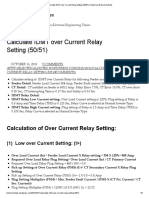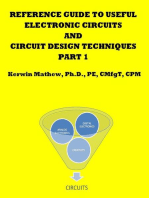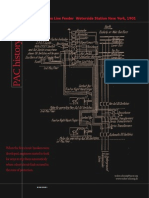0 ratings0% found this document useful (0 votes)
44 viewsPreview of "Electrical Thumb Rules You MUST Follow (Part 2) - EEP"
Preview of "Electrical Thumb Rules You MUST Follow (Part 2) - EEP"
Uploaded by
Battinapati ShivaElectrical Thumb rules
Copyright:
© All Rights Reserved
Available Formats
Download as PDF, TXT or read online from Scribd
Preview of "Electrical Thumb Rules You MUST Follow (Part 2) - EEP"
Preview of "Electrical Thumb Rules You MUST Follow (Part 2) - EEP"
Uploaded by
Battinapati Shiva0 ratings0% found this document useful (0 votes)
44 views4 pagesElectrical Thumb rules
Original Title
Preview of “Electrical Thumb Rules You MUST Follow (Part 2) | EEP”
Copyright
© © All Rights Reserved
Available Formats
PDF, TXT or read online from Scribd
Share this document
Did you find this document useful?
Is this content inappropriate?
Electrical Thumb rules
Copyright:
© All Rights Reserved
Available Formats
Download as PDF, TXT or read online from Scribd
Download as pdf or txt
0 ratings0% found this document useful (0 votes)
44 views4 pagesPreview of "Electrical Thumb Rules You MUST Follow (Part 2) - EEP"
Preview of "Electrical Thumb Rules You MUST Follow (Part 2) - EEP"
Uploaded by
Battinapati ShivaElectrical Thumb rules
Copyright:
© All Rights Reserved
Available Formats
Download as PDF, TXT or read online from Scribd
Download as pdf or txt
You are on page 1of 4
Home Technical Articles Article Categories Contact us Subscribe to articles Subscribe to
downloads El. Enginering Guides
EE General guides
Power Substations
Schneider Electric CTs
Siemens Basics of EE
ABB Drives Guides
Industry Automation
Relay control/protection
Alternative Energy
Electrical Software MS Excel Spreadsheets Electrical Design Docs Engineering Resources
Video Lectures Electrical Engineering
PLC Programming Training
Electric Testing and Maintenance (VIDEO)
Network Theorems and Laws
-
Electrical Thumb Rules You MUST Follow
(Part 2)
Electrical Thumb Rules You MUST Follow (Part 2) | EEP http://electrical-engineering-portal.com/electrical-thumb-rule...
1 of 4 01/08/14 12:38 PM
Electrical Thumb Rules You MUST Follow // PART 2 (on photo: Osprey Lunch Among The
Electrical Wires! by Kathleen Jackson via Flickr)
Continued from first part: Electrical Thumb Rules You MUST Follow (Part 1)
Useful Electrical Equations
For Sinusoidal Current: Form Factor = RMS Value/Average Value = 1.11
For Sinusoidal Current: Peak Factor = Max Value/RMS Value = 1.414
Average Value of Sinusoidal Current (I
av
) = 0.637 x Im (Im = Max.Value)
RMS Value of Sinusoidal Current (I
rms
) = 0.707 x Im (Im = Max.Value)
A.C Current = D.C Current/0.636.
Phase Difference between Phase = 360/ No of Phase (1 Phase=230/1=360, 2
Phase=360/2=180)
Short Circuit Level of Cable in KA (I
sc
) =
(0.094 x Cable Dia in Sq.mm) /! Short Circuit Time (Sec)
Max.Cross Section Area of Earthing Strip (mm2) = !(Fault Current x Fault Current x
Operating Time of Disconnected Device ) / K
K = Material Factor, K for Cu = 159, K for Al = 105, K for steel = 58 , K for GI = 80
Most Economical Voltage at given Distance = 5.5 x ! ((km/1.6) + (kw/100))
Cable Voltage Drop (%) =
(1.732 x current x (Rcos!+jsin!) x 1.732 x Length (km) x 100) / (Volt(L-L) x Cable Run.
Spacing of Conductor in Transmission Line (mm) = 500 + 18 x (P P Volt) + (2 x
(Span in Length)/50).
Protection radius of Lighnting Arrestor = !h x (2D-h) + (2D+L).
Where h= height of L.A, D-distance of equipment (20, 40, 60 Meter), L=V x t
(V=1m/ms, t=Discharge Time).
Size of Lightning Arrestor = 1.5x Phase to Earth Voltage or 1.5 x (System
Voltage/1.732).
Maximum Voltage of the System = 1.1xRated Voltage (Ex. 66KV = 1.1 " 66 =
72.6KV)
Load Factor = Average Power/Peak Power
If Load Factor is 1 or 100% = This is best situation for System and Consumer both.
If Load Factor is Low (0 or 25%) = you are paying maximum amount of KWH
Electrical Thumb Rules You MUST Follow (Part 2) | EEP http://electrical-engineering-portal.com/electrical-thumb-rule...
2 of 4 01/08/14 12:38 PM
consumption. Load Factor may be increased by switching or use of your Electrical
Application.
Demand Factor = Maximum Demand / Total Connected Load (Demand Factor <1)
Demand factor should be applied for Group Load
Diversity Factor =
Sum of Maximum Power Demand / Maximum Demand (Demand Factor >1)
Diversity factor should be consider for individual Load
Plant Factor (Plant Capacity) = Average Load / Capacity of Plant
Fusing Factor = Minimum Fusing Current / Current Rating (Fusing Factor>1).
Voltage Variation (1 to 1.5%) = ((Average Voltage Min Voltage) x 100)/Average Voltage
Ex: 462V, 463V, 455V, Voltage Variation= ((460 455) x 100)/455 = 1.1%.
Current Variation (10%) = ((Average Current Min Current) x 100)/Average Current
Ex: 30A,35A,30A, Current Variation = ((35-31.7) x 100)/31.7 = 10.4%
Fault Level at TC Secondary
= TC (VA) x 100 / Transformer Secondary (V) x Impedance (%)
Motor Full Load Current = Kw /1.732 x KV x P.F x Efficiency
Recommended EE articles
jiguparmar - Jignesh Parmar has completed his B.E(Electrical) from Gujarat
University. He is member of Institution of Engineers (MIE),India. Membership
No:M-1473586.He has more than 12 years experience in Transmission
-Distribution-Electrical Energy theft detection-Electrical Maintenance-Electrical
Projects (Planning-Designing-Technical Review-coordination -Execution). He is
Presently associate with one of the leading business group as a Assistant Manager
at Ahmedabad,India. He has published numbers of Technical Articles in "Electrical Mirror",
"Electrical India", "Lighting India", "Industrial Electrix"(Australian Power Publications)
Magazines. He is Freelancer Programmer of Advance Excel and design useful Excel base
Electrical Programs as per IS, NEC, IEC,IEEE codes. He is Technical Blogger and Familiar with
English, Hindi, Gujarati, French languages. He wants to Share his experience & Knowledge and
help technical enthusiasts to find suitable solutions and updating themselves on various
Engineering Topics.
Electrical Thumb Rules You MUST Follow (Part 2) | EEP http://electrical-engineering-portal.com/electrical-thumb-rule...
3 of 4 01/08/14 12:38 PM
2014 EEP - Electrical Engineering Portal. All Rights Reserved | Privacy Policy | 36 queries in
0.294 seconds.
Powered by CsanyiGroup
SHARE
TOP
Get
Electrical Thumb Rules You MUST Follow (Part 2) | EEP http://electrical-engineering-portal.com/electrical-thumb-rule...
4 of 4 01/08/14 12:38 PM
You might also like
- Electrical Installation Design GuideDocument97 pagesElectrical Installation Design GuideIbrahimSamir100% (55)
- NFPA70E ARC CalculatorDocument46 pagesNFPA70E ARC CalculatorRPantel100% (2)
- Practical Guides to Testing and Commissioning of Mechanical, Electrical and Plumbing (Mep) InstallationsFrom EverandPractical Guides to Testing and Commissioning of Mechanical, Electrical and Plumbing (Mep) InstallationsRating: 4 out of 5 stars4/5 (4)
- Solarpv ChecklistDocument6 pagesSolarpv ChecklistMohan KrishnaNo ratings yet
- Introduction to Power System ProtectionFrom EverandIntroduction to Power System ProtectionRating: 4 out of 5 stars4/5 (2)
- Aco-8 Maintainace Manual 1.02Document45 pagesAco-8 Maintainace Manual 1.02Farouq ShakerNo ratings yet
- Automated Broad and Narrow Band Impedance Matching for RF and Microwave CircuitsFrom EverandAutomated Broad and Narrow Band Impedance Matching for RF and Microwave CircuitsNo ratings yet
- Electrical Thumb Rules You MUST Follow (Part 1) - EEPDocument4 pagesElectrical Thumb Rules You MUST Follow (Part 1) - EEPAshokkumar ManoharanNo ratings yet
- Live Line Maintenance TechniquesDocument41 pagesLive Line Maintenance TechniquesBattinapati ShivaNo ratings yet
- CsdiffDocument31 pagesCsdiffydluNo ratings yet
- 1999 GMC SAVANA Service Repair Manual PDFDocument31 pages1999 GMC SAVANA Service Repair Manual PDFjhjfnsnefNo ratings yet
- Chapter - 9-Heat Transfer in Agitated VesselsDocument44 pagesChapter - 9-Heat Transfer in Agitated VesselsSata Ajjam100% (2)
- Software Defined Radio Handbook - 9th EditionDocument62 pagesSoftware Defined Radio Handbook - 9th EditionA. VillaNo ratings yet
- Electrical Thumb Rules (Part-2) - Electrical Notes & ArticlesDocument2 pagesElectrical Thumb Rules (Part-2) - Electrical Notes & ArticlesRajj Pruthivi100% (2)
- Electrical Thumb Rules (Part-2) PDFDocument2 pagesElectrical Thumb Rules (Part-2) PDFElectrical RadicalNo ratings yet
- Electrical Thumb Rules (Part-2)Document2 pagesElectrical Thumb Rules (Part-2)Electrical RadicalNo ratings yet
- Electrical Thumb Rules You MUST Follow (Part 2) - EEPDocument2 pagesElectrical Thumb Rules You MUST Follow (Part 2) - EEPSoe Min TunNo ratings yet
- 2 Electrical Thumb RulesDocument2 pages2 Electrical Thumb Ruleskalyan_mallaNo ratings yet
- Electrical Thumb Rules You MUST Follow (Part 2) - EEPDocument1 pageElectrical Thumb Rules You MUST Follow (Part 2) - EEPRadhaNo ratings yet
- Electrical Thumb Rules You MUST Follow Part 2Document2 pagesElectrical Thumb Rules You MUST Follow Part 2shaikhsajid242No ratings yet
- Electrical Thumb Rules You MUST Follow (Part 2)Document2 pagesElectrical Thumb Rules You MUST Follow (Part 2)vijaydev75100% (1)
- Useful Electrical Equations: Short Circuit LevelDocument2 pagesUseful Electrical Equations: Short Circuit LevelMuhammad AbubakrNo ratings yet
- Electrical Thumb Rules - (Part 1)Document4 pagesElectrical Thumb Rules - (Part 1)Electrical Radical100% (6)
- Trfo Voltage DropDocument16 pagesTrfo Voltage Dropshivvaram100% (1)
- Electrical Rule of The ThumbDocument3 pagesElectrical Rule of The Thumbedalzurc100% (2)
- An Example of Calculating Transformer Size and Voltage Drop Due To Starting of Large MotorDocument4 pagesAn Example of Calculating Transformer Size and Voltage Drop Due To Starting of Large MotorPierre Enrique Carrasco FuentesNo ratings yet
- An Example How To Calculate Voltage Drop and Size of Electrical CableDocument8 pagesAn Example How To Calculate Voltage Drop and Size of Electrical CablesandystaysNo ratings yet
- Electrical Thumb Rules You MUST Follow Part 1Document5 pagesElectrical Thumb Rules You MUST Follow Part 1shaikhsajid242No ratings yet
- 7Document7 pages7E.ANANDANNo ratings yet
- Calculating TransformeDocument5 pagesCalculating Transformekrit_kasemNo ratings yet
- An Example How To Calculate Voltage Drop and Size of Electrical Cable - EEP PDFDocument8 pagesAn Example How To Calculate Voltage Drop and Size of Electrical Cable - EEP PDFtatianaNo ratings yet
- Electrical Thumb Rules - (Part 1)Document4 pagesElectrical Thumb Rules - (Part 1)rajdeep maity100% (2)
- Comparison of Protection Relay TypesDocument8 pagesComparison of Protection Relay TypesPierre Enrique Carrasco FuentesNo ratings yet
- Electrical Thumb Rules You MUST Follow (Part 1) - EEPDocument8 pagesElectrical Thumb Rules You MUST Follow (Part 1) - EEPadeel akbarNo ratings yet
- An Example of Calculating Transformer Size and Voltage Drop Due To Starting of Large MotorDocument3 pagesAn Example of Calculating Transformer Size and Voltage Drop Due To Starting of Large MotorSujith SukumaranNo ratings yet
- Power Distribution Basics - Pps (Compatibility Mode)Document57 pagesPower Distribution Basics - Pps (Compatibility Mode)Chaitanya MajalukodiNo ratings yet
- Trfo Voltage DropDocument74 pagesTrfo Voltage DropshivvaramNo ratings yet
- Calculate IDMT Over Current Relay Setting 50 51 Electrical Notes ArticlesDocument5 pagesCalculate IDMT Over Current Relay Setting 50 51 Electrical Notes ArticlesTom100% (1)
- Electrical Thumb Rules (Part-2)Document4 pagesElectrical Thumb Rules (Part-2)AriesFranandaPanjaitanNo ratings yet
- Electrical Engineering Portal Com Electrical Thumb Rules You Must Follow Part 2Document8 pagesElectrical Engineering Portal Com Electrical Thumb Rules You Must Follow Part 2m khNo ratings yet
- Arc Flash PalawanDocument58 pagesArc Flash PalawanChristopher BalbuenaNo ratings yet
- Calculate IDMT Over Current Relay Setting (50 - 51) - Electrical Notes & ArticlesDocument5 pagesCalculate IDMT Over Current Relay Setting (50 - 51) - Electrical Notes & ArticlesThức Võ100% (1)
- Calculate IDMT Over Current Relay Setting (50 - 51)Document7 pagesCalculate IDMT Over Current Relay Setting (50 - 51)Woei Song OoiNo ratings yet
- Calculate IDMT Over Current Relay Setting 50 51 Electrical Notes Articles PDFDocument5 pagesCalculate IDMT Over Current Relay Setting 50 51 Electrical Notes Articles PDFVelu SamyNo ratings yet
- Calculate IDMT Over Current Relay Setting 50 51 Electrical Notes ArticlesDocument5 pagesCalculate IDMT Over Current Relay Setting 50 51 Electrical Notes ArticlesVelu SamyNo ratings yet
- Calculate IDMT Over Current Relay Setting 50 51 Electrical Notes Articles PDFDocument5 pagesCalculate IDMT Over Current Relay Setting 50 51 Electrical Notes Articles PDFJalla Siddeswara Reddy100% (1)
- Power System Protection (EE-523) Lecture-01: Samiya Zafar Assistant Professor, EED NEDUET M.Engg Fall Semester 2017Document47 pagesPower System Protection (EE-523) Lecture-01: Samiya Zafar Assistant Professor, EED NEDUET M.Engg Fall Semester 2017Jalees100% (1)
- Terminating and Connecting of Electrical Wirings and Electronics Circuits - Part1Document43 pagesTerminating and Connecting of Electrical Wirings and Electronics Circuits - Part1Ronaldo PalomaNo ratings yet
- Analysis of The Effect of An Installatio 3Document10 pagesAnalysis of The Effect of An Installatio 3Zulfatri AiniNo ratings yet
- Impulse Voltage Generation Using MATLAB/Simulink and Its Integration in Undergraduate High Voltage Engineering CourseDocument6 pagesImpulse Voltage Generation Using MATLAB/Simulink and Its Integration in Undergraduate High Voltage Engineering CourseHamzah RezaNo ratings yet
- Useful Electrical OperationsDocument53 pagesUseful Electrical Operationsthegemishere100% (2)
- Null 5Document96 pagesNull 5mohammedNo ratings yet
- Fault Diagnosis Algorithm and ProtectionDocument9 pagesFault Diagnosis Algorithm and Protectionaustin.oshinNo ratings yet
- Electrical Thumb Rules - (Part 1)Document8 pagesElectrical Thumb Rules - (Part 1)AriesFranandaPanjaitanNo ratings yet
- Calculate Idmt PDFDocument6 pagesCalculate Idmt PDFShuvan MabuNo ratings yet
- Arc FlashDocument15 pagesArc FlashramlijavierNo ratings yet
- Difference Between Power Transformer and Distribution Transformer - EEPDocument3 pagesDifference Between Power Transformer and Distribution Transformer - EEPpalak ariwalaNo ratings yet
- Catalogo General de Productos EPCOS 2013Document96 pagesCatalogo General de Productos EPCOS 2013aresmecanicoNo ratings yet
- Calculate IDMT Over Current Relay Setting (50 - 51) - Electrical Notes & ArticlesDocument10 pagesCalculate IDMT Over Current Relay Setting (50 - 51) - Electrical Notes & ArticlesGirish Raghavendra Rao0% (1)
- Upload Login SignupDocument30 pagesUpload Login Signupkumelachewbirre22No ratings yet
- Motor Protection Application GuideDocument28 pagesMotor Protection Application Guidekvasquez1979No ratings yet
- PSP Manual 13Document10 pagesPSP Manual 13Muhammad AnsNo ratings yet
- Ijireeice 18Document3 pagesIjireeice 18creative risersNo ratings yet
- Durraiz Fyp 2Document3 pagesDurraiz Fyp 2durraiz shuaibNo ratings yet
- Quick Review Outline - Masschusetts Testing for Educator Licensure (MTEL) Tech and Eng ExamFrom EverandQuick Review Outline - Masschusetts Testing for Educator Licensure (MTEL) Tech and Eng ExamNo ratings yet
- Influence of System Parameters Using Fuse Protection of Regenerative DC DrivesFrom EverandInfluence of System Parameters Using Fuse Protection of Regenerative DC DrivesNo ratings yet
- Reference Guide To Useful Electronic Circuits And Circuit Design Techniques - Part 1From EverandReference Guide To Useful Electronic Circuits And Circuit Design Techniques - Part 1Rating: 2.5 out of 5 stars2.5/5 (3)
- Different MPPT TechniquesDocument10 pagesDifferent MPPT TechniquesphanioletyNo ratings yet
- Mersen PVPN5 Sizing Fuses of PV Systems Per NECDocument4 pagesMersen PVPN5 Sizing Fuses of PV Systems Per NECchendo2006No ratings yet
- Bus Differential Protection: Fundamental IdeasDocument8 pagesBus Differential Protection: Fundamental IdeasBattinapati ShivaNo ratings yet
- VSN800 Weather Station Product ManualDocument16 pagesVSN800 Weather Station Product ManualBattinapati ShivaNo ratings yet
- Guide To The Installation of PV Systems - 2nd EditionDocument32 pagesGuide To The Installation of PV Systems - 2nd Editionnikanako100% (5)
- 1hyb990052 16aDocument1 page1hyb990052 16aBattinapati ShivaNo ratings yet
- VCBDocument1 pageVCBBattinapati ShivaNo ratings yet
- Distance Protection: © ZIV Aplicaciones y Tecnología S. ADocument96 pagesDistance Protection: © ZIV Aplicaciones y Tecnología S. ABattinapati ShivaNo ratings yet
- Drawingsdocumentsrequiredforsolarprojects 131110061739 Phpapp01Document4 pagesDrawingsdocumentsrequiredforsolarprojects 131110061739 Phpapp01Battinapati Shiva100% (1)
- Gas Turbine Power StationDocument43 pagesGas Turbine Power StationBattinapati Shiva100% (1)
- Circuit BreakerDocument137 pagesCircuit BreakerBattinapati Shiva100% (5)
- Earth Mat LayoutDocument2 pagesEarth Mat LayoutBattinapati ShivaNo ratings yet
- EE DiagramsDocument35 pagesEE DiagramsRai JeanNo ratings yet
- SLDDocument1 pageSLDBattinapati ShivaNo ratings yet
- Intro To ERP (Induction Level Training)Document19 pagesIntro To ERP (Induction Level Training)Battinapati ShivaNo ratings yet
- Drafting Electrical DrawingsDocument168 pagesDrafting Electrical DrawingsBattinapati Shiva50% (2)
- Newmicrosoftofficepowerpointpresentation 130309031327 Phpapp02 PDFDocument38 pagesNewmicrosoftofficepowerpointpresentation 130309031327 Phpapp02 PDFtaiptc4No ratings yet
- Nuclear Power: Presentation By: Shri. Bharat V. Makhare Asst. Engineer, NTC, Nashik MahagencoDocument67 pagesNuclear Power: Presentation By: Shri. Bharat V. Makhare Asst. Engineer, NTC, Nashik MahagencoBattinapati ShivaNo ratings yet
- Delegation of PowerDocument68 pagesDelegation of PowerBattinapati ShivaNo ratings yet
- HVDC PPTDocument34 pagesHVDC PPTBattinapati Shiva100% (2)
- Cables, Conduits and Trunking: To The 16th Edition IEE RegulationsDocument2 pagesCables, Conduits and Trunking: To The 16th Edition IEE RegulationsBattinapati ShivaNo ratings yet
- LINK-History of ProtectionDocument7 pagesLINK-History of ProtectionBattinapati ShivaNo ratings yet
- Oc Relay CordinationDocument47 pagesOc Relay CordinationBattinapati ShivaNo ratings yet
- Project Management PresentationDocument15 pagesProject Management PresentationBattinapati Shiva100% (3)
- Info - Tech. Model PaperDocument8 pagesInfo - Tech. Model PaperAnaryanNo ratings yet
- Mercure Hotel Barsha Heights - MOSDocument5 pagesMercure Hotel Barsha Heights - MOS4jan1980No ratings yet
- Chemical Waste GNDocument14 pagesChemical Waste GNgangsNo ratings yet
- Contents of The ProjectDocument130 pagesContents of The ProjectjmsjingoNo ratings yet
- 1st-IA (Room Allotment - 5th Semester)Document8 pages1st-IA (Room Allotment - 5th Semester)muskansahani.cseaiml.amcecNo ratings yet
- UGL2320A 34830H71 RevADocument16 pagesUGL2320A 34830H71 RevApatel909No ratings yet
- PRT Lecture - 16 17Document30 pagesPRT Lecture - 16 17HimaNo ratings yet
- DIWAN DEODI, Hyderabad PDFDocument18 pagesDIWAN DEODI, Hyderabad PDFTANYA SRIVASTAVANo ratings yet
- CEE ME CEE 108 Umbay&Donayre Rev1Document181 pagesCEE ME CEE 108 Umbay&Donayre Rev1Renz Eric Garcia UlandayNo ratings yet
- Question 1Document9 pagesQuestion 1Romelyn BaptistaNo ratings yet
- CcmsDocument7 pagesCcmsAnant SinghNo ratings yet
- Figure 2.3.3.1-1 Erection Using Two CranesDocument50 pagesFigure 2.3.3.1-1 Erection Using Two CranesIan SNo ratings yet
- LAB 1: Per Unit System in Transmission and DistributionDocument13 pagesLAB 1: Per Unit System in Transmission and Distributionsemuty92No ratings yet
- Keltron Electrolytic CapacitorDocument9 pagesKeltron Electrolytic CapacitorMahesh SatheNo ratings yet
- Water Technology-2Document16 pagesWater Technology-2Anjan Prasad100% (1)
- MAINTENANCE REPORT of MITSUBISHI Diesel Engine Generator SetDocument4 pagesMAINTENANCE REPORT of MITSUBISHI Diesel Engine Generator Setali sNo ratings yet
- Project Construction Manager Resume Example National Petroleum Construction Company - Horicon, WisconsinDocument4 pagesProject Construction Manager Resume Example National Petroleum Construction Company - Horicon, WisconsinRakesh DasNo ratings yet
- Soil Survey Standard Test Method Soil Moisture Content: Department of Sustainable Natural ResourcesDocument5 pagesSoil Survey Standard Test Method Soil Moisture Content: Department of Sustainable Natural ResourcesKhairunniza Azizi KarimNo ratings yet
- Chapter 8Document44 pagesChapter 8Pirate CaribbeanNo ratings yet
- Catalogo de Partes 1104D-44TG1 (NL70981B)Document198 pagesCatalogo de Partes 1104D-44TG1 (NL70981B)Brian Vellaneda100% (1)
- Banana Peels Based Bio-PlasticDocument7 pagesBanana Peels Based Bio-PlasticJULISSANo ratings yet
- Geoelectric Strike and Its Application in MagnetotelluricsDocument40 pagesGeoelectric Strike and Its Application in MagnetotelluricsamiruddinNo ratings yet
- Advantage and Disadvantage of Cell PhoneDocument5 pagesAdvantage and Disadvantage of Cell PhoneSyed Awon Hussain ShahNo ratings yet
- 1815 Massachusetts Ave. Riverside CA 92507 951.369.5144 Phone 951.369.7266 FaxDocument4 pages1815 Massachusetts Ave. Riverside CA 92507 951.369.5144 Phone 951.369.7266 FaxTobengNo ratings yet
- Volvo Penta Tamd61a-72j-A WM Fuelsystem PDFDocument44 pagesVolvo Penta Tamd61a-72j-A WM Fuelsystem PDFOzgyur MehmedovNo ratings yet




















































































































